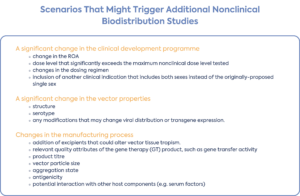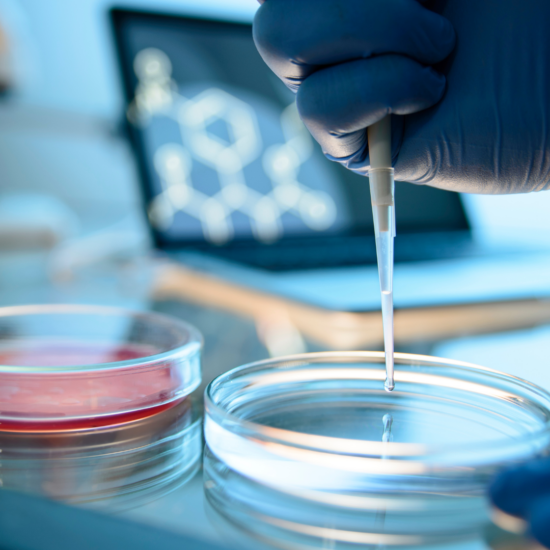Human gene therapy (GT) is defined as the treatment, prevention or diagnosis of any disorder or disease by transferring engineered genetic material into human cells (e.g. via viral transduction), and comes under advanced therapy medicinal products (ATMPs). Gene therapy (GT) is customisable for various tissue targets to treat diverse clinical indications ranging from neuromuscular diseases to cancer. As with any other medicinal product generated in anticipation of human administration, gene therapy (GT) products also require extensive information from their nonclinical studies to assess the risk-benefit before entering first-in-human studies. With rapid advances in gene therapy (GT), careful design and assessment of nonclinical studies of gene therapy (GT) products have become increasingly important for their successful clinical outcomes. Among the nonclinical studies, biodistribution (BD) assessments are fundamental in providing information on the persistence, duration of effect, and target organs (desired and undesired) to support the safety and efficacy of gene therapy (GT) products. Biodistribution (BD) is the in vivo distribution, persistence, and clearance of a product at the site of administration and in target and non-target tissues, including biofluids (e.g. blood, cerebrospinal fluid, vitreous fluid) in nonclinical animal models.
This article aims to provide a broad summary of the recent ICH S12 guideline – a harmonised definition for nonclinical biodistribution (BD) and conveys overall considerations for assessing biodistribution (BD) for gene therapy (GT) products – which came into effect from the 30th of September 2023. The recommendations in the guideline aim to facilitate the development of investigational gene therapy (GT) products while avoiding the unnecessary use of animals in line with the 3R (reduce/refine/replace) principle. Characterisation of the biodistribution (BD) profile following the administration of a gene therapy (GT) product in animals is a critical component of a nonclinical development programme. Nonclinical biodistribution (BD) data contributes to the overall interpretation of a study by enabling a better understanding of the relationship between the findings (desired and undesired) and the administered gene therapy (GT) product. Attribution of observed findings in animals to the genetic material (DNA/RNA) and/or to the expression product(s) factor into ascertaining a potential benefit-risk profile of the gene therapy (GT) product before administration in humans. Biodistribution (BD) data such as the route of administration (ROA), dose level(s), dosing regimen, and animal immune response can also inform elements of a first-in-human trial and subsequent clinical trials.

What Comes Under The Scope of ICH S12 Guideline Principles?
- Products that mediate their effect by the expression (transcription or translation) of transferred genetic materials:
-
- purified nucleic acid (e.g. plasmids and RNA)
- genetically modified microorganisms (e.g. viruses, bacteria, fungi) to express transgenes (including products that edit the host genome)
- ex vivo genetically modified human cells
- Products intended to alter the host cell genome in vivo without specific transcription or translation i.e. delivery of a nuclease and guide RNA by non-viral methods.
- Oncolytic viruses that are not genetically modified to express a transgene (although in certain regions, these viruses are not currently considered gene therapy (GT)).
What Does Not Come Under The Scope of ICH S12 Guideline Principles?

Study Design Considerations
Nonclinical biodistribution (BD) studies can be stand-alone or performed together with nonclinical pharmacology and toxicology studies.
GLP (Good Laboratory Practice) Compliance
- In principle, nonclinical biodistribution (BD) studies and BD sample analyses that are non-GLP are acceptable. However, it is important to verify the data quality, integrity, and reliability of any non-GLP BD evaluations.
- For BD evaluations performed as part of a GLP-compliant toxicology study, all in-life evaluations and sample collection procedures should remain GLP-compliant.
Test Article
- The test article should be representative of the intended clinical gene therapy (GT) product taking into consideration the following:
-
- manufacturing process
- important product characteristics (such as titre)
- the final clinical formulation
- It may be possible to leverage nonclinical BD data generated with a GT product consisting of the same vector intended for clinical use and a different therapeutic transgene or an expression marker gene.
Animal Model
- Biodistribution (BD) assessment should be conducted in a biologically relevant animal species or model that supports the transfer and expression of the genetic material.
- Selected animal species/models should produce a profile of dose-related gene therapy (GT) product tissue distribution and gene product expression similar to that in humans.
- Selection factors such as species differences in tissue tropism of the GT product, gene transfer efficiency, and transgene expression in target and non-target tissues/cells, should be considered.
- When testing replication-competent viral vector-based GT products, animal species/model permissive to vector replication should be chosen.
- Species, sex, age, and physiologic condition (e.g. healthy animal vs. animal disease model) can influence the BD profile.
- Consider if the selected animal species/model has the potential to mount an immune response against the administered vector and/or expression product.
Group Size and Sex of Animals
- Evaluation of an appropriate number of animals per sex (as applicable) at each predetermined sampling time point to generate sufficient data that supports comprehensive biodistribution (BD) assessment should be considered.
- Evaluation from a minimum of 5 rodents or 3 non-rodents per sex/group/time point is recommended.
- Justification should be provided for the number and sex (when testing is performed only in one sex) of the animals evaluated at each time point.
- Following the 3R (reduce/refine/replace) principles, the total number of animals can be an aggregate from several studies (with appropriate justification).
Route of Administration (ROA) and Dose Selection
- ROA for nonclinical biodistribution (BD) studies and intended clinical studies should be the same (if feasible).
- The selected dose levels should provide adequate characterisation of the BD profile to interpret the pharmacological and toxicological assessments.
- The dose level for BD evaluation should equate to or exceed the anticipated maximum clinical dose level but not exceed the highest dose level used in the toxicology study.
Sample Collection
- Appropriate procedures should be designed for sample collection (from target and non-target tissues and biofluids) to minimise the potential for contamination.
- A pre-specified process for appropriate retention of the samples obtained from each animal (vehicle control and gene therapy (GT) treated groups), along with the documentation of the order of sample collection is recommended.
- Sample collection time points should be selected to sufficiently characterise the time-related changes in GT product levels over appropriate time points.
- Consider the inclusion of additional time points (as applicable) to
-
- comprehensively capture the length of the steady-state period
- estimate persistence
- permit evaluation of GT product levels after repeat administration
- The collected samples should include (but are not limited to) panels of tissues/biofluids from the injection site(s), gonads, adrenal gland, brain, spinal cord (cervical, thoracic, and lumbar), liver, kidney, lung, heart, spleen, and blood.
- Sample panel collection should be guided by an understanding of the GT product under investigation, and factors such as vector type/tissue tropism, the expression product, ROA, and disease pathophysiology, for example, will contribute to the final decision.
Specific considerations
Assay Methodologies
- Evaluation of the biodistribution (BD) profile necessitates quantitation of
-
- the amount of genetic material (DNA/RNA), and, if appropriate, the expression product(s) of the gene therapy (GT) product in tissues/biofluids
- vector genome and/or transgene DNA/RNA relative to input genomic DNA by established nucleic acid amplification methods (e.g. qPCR, digital PCR, etc.) are considered the standard for detecting GT products in tissues/biofluids over time.
- When cellular content varies significantly in a sample (e.g. biofluids), DNA/RNA concentration can be assessed.
- Spike and recovery experiments, considered a part of assay development, should be performed to demonstrate the ability to detect the target nucleic acid sequence in different tissues/biofluids.
- Other techniques that can be used to monitor BD of a vector and/or the expression product(s) include (but are not limited to) enzyme-linked immunosorbent assay (ELISA), immunohistochemistry (IHC), western blot, in situ hybridisation (ISH), flow cytometry, various in vivo and ex vivo imaging techniques, and other evolving technologies.
- A comprehensive description of the methodology and the justification for the technique used, including the performance parameters of the method (e.g. sensitivity and reproducibility), should be provided.
Measuring Expression Products
- Quantifying the genetic material of the gene therapy (GT) product is the primary biodistribution (BD) assessment.
- Consider a risk-based approach – that includes GT product levels and persistence in tissues/biofluids, the target clinical population, and potential safety concerns associated with the vector and/or the expression product – to characterise the safety and activity profiles following GT product administration.
Immunological Considerations
Immune responses to transgenes or vectors pose substantial hurdles to clinical development and their broad use in patients. Therefore, nonclinical immunological assessments of gene therapy (GT) products are extremely important.
- Pre-existing immunity against a GT product in animals, notably in non-human primates and other non-rodent species could affect the BD profile.
- Before including a vector in a nonclinical study, pre-existing immunity screening in animals to that vector should be considered.
- Immunosuppression of animals for BD profile evaluation is not recommended. However, justification is required if product- or species-specific circumstances warrant immunosuppression.
- Collecting samples for possible immunogenicity analysis to support the interpretation of the BD data can be considered as the cell-mediated or humoral immune response to the GT product can occur after administration of the GT product.
- To circumvent the effects of the cell-mediated or humoral immune response to the expression product(s), species-specific orthologous transgene can be considered.
Ex Vivo Genetically Modified Cells
- Biodistribution (BD) assessment considerations for ex vivo genetically modified cells should include factors such as the cell type, ROA, and the potential for the expression product or gene modification event to affect the expected distribution of the cells within the body (e.g. new or altered expression of cell adhesion molecules).
- The occurrence of graft versus host disease in animals can complicate the interpretation of BD assessment (e.g. genetically modified human T cells)
- BD assessment of ex vivo genetically modified cells of haematopoietic origin is not critical, as systemic administration of these cells result in a widespread distribution.
- BD assessment of select tissues should be considered in appropriate animal species/models if the distribution of ex vivo genetically modified cells to a target organ(s)/tissue(s) is expected.
Biodistribution (BD) Assessment in Gonadal Tissues
- Biodistribution (BD) assessments of the administered gene therapy (GT) product in gonads of animals from both sexes are necessary unless the GT product is for a condition specific to one sex (e.g. for the treatment of prostate cancer or uterine cancer).
- Persistent GT product presence in the gonads can lead to additional studies to determine GT product levels in germline cells (e.g. oocytes, sperm) or non-germline cells in the animals.
- Persistence of the GT product in the germline cells, vector type, replication capacity, integration potential, dose level, ROA, etc. can inform the risk of inadvertent germline integration or germline cell genome modification. For a more comprehensive discussion on inadvertent germline integration see ICH considerations on General Principles to Address the Risk of Inadvertent Germline Integration of Gene Therapy Vectors.
- GT product persistence in non-germline cells (e.g. leukocytes, Sertoli cells or Leydig cells) of gonadal tissues can warrant additional consideration of its potential effect on the function of the affected non-germline cells, particularly if the cell type is important to successful reproduction.

Summary
The ICH S12 guideline discussed in this article provides recommendations for the conduct of nonclinical biodistribution (BD) studies in the development of gene therapy (GT) products, including the overall design of nonclinical BD assessments, interpretation and application of the BD data to support a nonclinical development programme, and the clinical trial design of GT products. Therefore, incorporating these topics in early discussions of the nonclinical program with the appropriate regulatory authority can facilitate product development.
For any related queries, contact DLRC at hello@dlrcgroup.com or use the link below. Our team of highly experienced ATMP and nonclinical regulatory experts will not only assist your preparations but also participate in such discussions with you to maximise your exchange with regulatory authorities.












